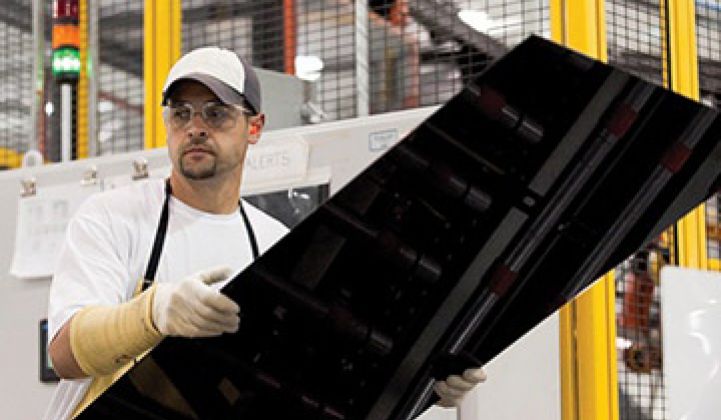Three investment banks have taken a negative stance on First Solar (NASDAQ: FSLR), the second largest solar panel manufacturer by capacity, and the first by market cap and profit.
Equity analysts at JPMorgan Chase (NYSE: JPM) lowered their price target on shares of First Solar to $105.00 in a research note to investors on Friday. JPMorgan believes the firm will have to lower module prices because of aggressive competition.
Analysts at Citigroup (NYSE: C) cut their price target on First Solar shares from $150.00 to $130.00 in a research note to investors last week. They have a "hold" rating on the stock.
And analysts at Maxim Group initiated coverage on First Solar in a research note on Thursday with a "sell" rating and an $85.00 price target on the stock.
Maxim saw "long-term earnings under threat in a $1.00 per watt" solar panel world, saying that this pricing has accelerated the maturity of the solar industry and "threatens First Solar's competitive advantage and LT EPS power." Maxim added: "While FSLR rode the lowest costs in the industry to a leading market share, a drop in silicon costs has enabled c-Si prices to fall to levels that have dramatically narrowed FSLR’s cost advantage."
Maxim sees 2011 EPS guidance at risk and earnings power inflated by high-priced PPA contracts that will soon give way to "normalized PPA prices" of $0.12 per kilowatt-hour. Maxim estimates "external ASPs of $0.78 per watt, cost per watt of $0.57, total gross margin of 32 percent, and EPS of $8.65 by 2014."
First Solar last announced its quarterly results in early May, reporting $1.33 earnings per share for the previous quarter with flat revenue from quarter to quarter.
“Despite European market uncertainties, First Solar has good visibility into our demand for 2011,” said Rob Gillette, the CEO of First Solar, at the most recent earnings call.
In an article we published about a year ago, "Why I Am Short First Solar," John Hempton of Bronte Capital made the following points:
- First Solar is a company that improved the world. It has driven the cost of solar cell production to quite low levels and made utility-scale solar farms viable with only modest subsidies. There are some places where solar is now viable without subsidies. We can think of few other companies that have pushed a technology so far and with such high environmental benefits. Companies like this will allow us to maintain a modern lifestyle while addressing greenhouse emissions issues.
- Still, for all the benefits of First Solar’s cells, they are inferior in many important ways to a polycrystalline cell. Their efficiency is lower -- which means you do not get as much solar energy off the constrained roof space. Secondly, while they save a lot on the semiconductor part of the manufacturing process, they have to use more glass, more wires, etc., to generate the same amount of solar electricity. Each cell generates less electricity, as well, so inverters, connectors, and installations all cost more with thin film. Thin film also degrades over time. First Solar warrants their performance over their lifetime -- but with the warranty accounting for lower levels of performance in the second decade of operation (google 'Staebler-Wronski effect' for a non-trivial explanation). Thin film does, however, have some advantages in low light, such as the ability to retain a slightly greater proportion of their peak capacity.
- There is a distinct possibility that First Solar's business will fail in the same way that Palm's or Garmin's has. It won't be fair -- but fairness has nothing to do with it. Like Garmin, First Solar probably won't go bust because it has a billion dollars in liquid assets on the balance sheet -- assets which represent past profits.
- This company is a technological wonder. Glass goes in on one end of the manufacturing process and comes out as solar cells at the other with next to no human intervention. Labor is used only when it comes to putting frames around the glass and for similar tasks.
- To recap, in order to make money in technology, you need to do two things. First, you need to change the world (which First Solar clearly did), and second, you need to keep the competition out. Alas, very few businesses manage the second trick.
-
First Solar’s advantage is entirely dependent on the fact that they use much less semiconductor material than wafers -- an advantage that disappears entirely as wafer prices fall. At that point, all of First Solar’s many disadvantages will begin to shine through. If that happens, First Solar is toast. It probably won’t file bankruptcy, because it has so much in past profits to fall back on, but it will be every bit as obsolete as a Palm organizer is now or as a Garmin car-based navigation system might be in five years.
The future holds the potential for a bloody price war between Suntech (STP), Yingli (YGE), SunPower (SPWRA), and other silicon solar vendors. First Solar, despite its technology advantage, will eventually be drawn into that fray. And it will become especially interesting when the likes of GE, Samsung, AU Optronics, and Solar Frontier make their full-scale entrance.
Can First Solar's margins remain strong even with PPA pricing at $0.10 per kilowatt-hour? Perhaps -- if the company executes on its long-term cost-reduction roadmap.
First Solar's stock is currently trading at $116.56, down 4.81 percent, with a market capitalization of $10.04 billion.



